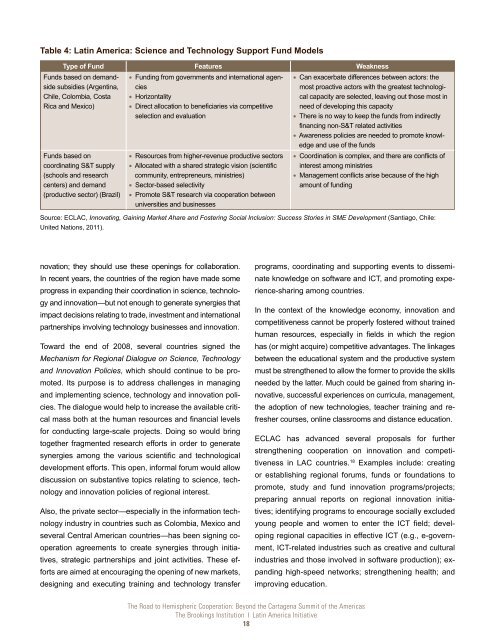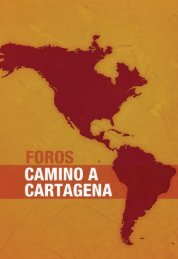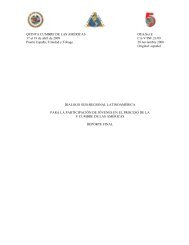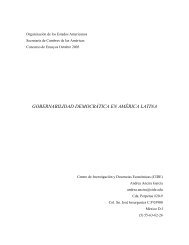The Road to Hemispheric Cooperation: Beyond the Cartagena
The Road to Hemispheric Cooperation: Beyond the Cartagena
The Road to Hemispheric Cooperation: Beyond the Cartagena
You also want an ePaper? Increase the reach of your titles
YUMPU automatically turns print PDFs into web optimized ePapers that Google loves.
Table 4: Latin America: Science and Technology Support Fund Models<br />
Type of Fund Features Weakness<br />
Funds based on demand- ● Funding from governments and international agen- ● Can exacerbate differences between ac<strong>to</strong>rs: <strong>the</strong><br />
side subsidies (Argentina, cies<br />
most proactive ac<strong>to</strong>rs with <strong>the</strong> greatest technologi-<br />
Chile, Colombia, Costa<br />
● Horizontality<br />
cal capacity are selected, leaving out those most in<br />
Rica and Mexico)<br />
● Direct allocation <strong>to</strong> beneficiaries via competitive need of developing this capacity<br />
selection and evaluation<br />
● <strong>The</strong>re is no way <strong>to</strong> keep <strong>the</strong> funds from indirectly<br />
financing non-S&T related activities<br />
● Awareness policies are needed <strong>to</strong> promote knowledge<br />
and use of <strong>the</strong> funds<br />
Funds based on<br />
● Resources from higher-revenue productive sec<strong>to</strong>rs ● Coordination is complex, and <strong>the</strong>re are conflicts of<br />
coordinating S&T supply ● Allocated with a shared strategic vision (scientific interest among ministries<br />
(schools and research community, entrepreneurs, ministries)<br />
● Management conflicts arise because of <strong>the</strong> high<br />
centers) and demand<br />
● Sec<strong>to</strong>r-based selectivity<br />
amount of funding<br />
(productive sec<strong>to</strong>r) (Brazil) ● Promote S&T research via cooperation between<br />
universities and businesses<br />
Source: ECLAC, Innovating, Gaining Market Ahare and Fostering Social Inclusion: Success S<strong>to</strong>ries in SME Development (Santiago, Chile:<br />
United Nations, 2011).<br />
novation; <strong>the</strong>y should use <strong>the</strong>se openings for collaboration.<br />
In recent years, <strong>the</strong> countries of <strong>the</strong> region have made some<br />
progress in expanding <strong>the</strong>ir coordination in science, technology<br />
and innovation—but not enough <strong>to</strong> generate synergies that<br />
impact decisions relating <strong>to</strong> trade, investment and international<br />
partnerships involving technology businesses and innovation.<br />
Toward <strong>the</strong> end of 2008, several countries signed <strong>the</strong><br />
Mechanism for Regional Dialogue on Science, Technology<br />
and Innovation Policies, which should continue <strong>to</strong> be promoted.<br />
Its purpose is <strong>to</strong> address challenges in managing<br />
and implementing science, technology and innovation policies.<br />
<strong>The</strong> dialogue would help <strong>to</strong> increase <strong>the</strong> available critical<br />
mass both at <strong>the</strong> human resources and financial levels<br />
for conducting large-scale projects. Doing so would bring<br />
<strong>to</strong>ge<strong>the</strong>r fragmented research efforts in order <strong>to</strong> generate<br />
synergies among <strong>the</strong> various scientific and technological<br />
development efforts. This open, informal forum would allow<br />
discussion on substantive <strong>to</strong>pics relating <strong>to</strong> science, technology<br />
and innovation policies of regional interest.<br />
Also, <strong>the</strong> private sec<strong>to</strong>r—especially in <strong>the</strong> information technology<br />
industry in countries such as Colombia, Mexico and<br />
several Central American countries—has been signing cooperation<br />
agreements <strong>to</strong> create synergies through initiatives,<br />
strategic partnerships and joint activities. <strong>The</strong>se efforts<br />
are aimed at encouraging <strong>the</strong> opening of new markets,<br />
designing and executing training and technology transfer<br />
programs, coordinating and supporting events <strong>to</strong> disseminate<br />
knowledge on software and ICT, and promoting experience-sharing<br />
among countries.<br />
In <strong>the</strong> context of <strong>the</strong> knowledge economy, innovation and<br />
competitiveness cannot be properly fostered without trained<br />
human resources, especially in fields in which <strong>the</strong> region<br />
has (or might acquire) competitive advantages. <strong>The</strong> linkages<br />
between <strong>the</strong> educational system and <strong>the</strong> productive system<br />
must be streng<strong>the</strong>ned <strong>to</strong> allow <strong>the</strong> former <strong>to</strong> provide <strong>the</strong> skills<br />
needed by <strong>the</strong> latter. Much could be gained from sharing innovative,<br />
successful experiences on curricula, management,<br />
<strong>the</strong> adoption of new technologies, teacher training and refresher<br />
courses, online classrooms and distance education.<br />
ECLAC has advanced several proposals for fur<strong>the</strong>r<br />
streng<strong>the</strong>ning cooperation on innovation and competitiveness<br />
in LAC countries. 18 Examples include: creating<br />
or establishing regional forums, funds or foundations <strong>to</strong><br />
promote, study and fund innovation programs/projects;<br />
preparing annual reports on regional innovation initiatives;<br />
identifying programs <strong>to</strong> encourage socially excluded<br />
young people and women <strong>to</strong> enter <strong>the</strong> ICT field; developing<br />
regional capacities in effective ICT (e.g., e-government,<br />
ICT-related industries such as creative and cultural<br />
industries and those involved in software production); expanding<br />
high-speed networks; streng<strong>the</strong>ning health; and<br />
improving education.<br />
<strong>The</strong> <strong>Road</strong> <strong>to</strong> <strong>Hemispheric</strong> <strong>Cooperation</strong>: <strong>Beyond</strong> <strong>the</strong> <strong>Cartagena</strong> Summit of <strong>the</strong> Americas<br />
<strong>The</strong> Brookings Institution ❘ Latin America Initiative<br />
18








